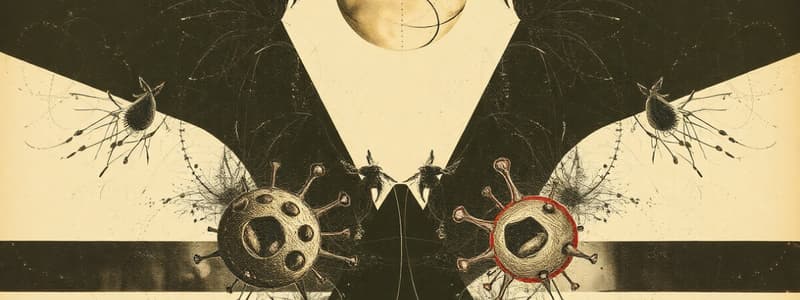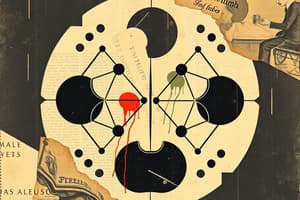Podcast
Questions and Answers
What structure forms in plant cells during division to separate daughter cells?
What structure forms in plant cells during division to separate daughter cells?
- Cell plate (correct)
- Cell membrane
- Nucleus
- Centrioles
What is the term for cells that have a single set of chromosomes?
What is the term for cells that have a single set of chromosomes?
- Haploid cells (correct)
- Zygote cells
- Diploid cells
- Somatic cells
What is the diploid number of chromosomes for humans?
What is the diploid number of chromosomes for humans?
- 69
- 23
- 92
- 46 (correct)
During fertilization, what is formed when male and female gametes combine?
During fertilization, what is formed when male and female gametes combine?
In which organs does meiosis occur?
In which organs does meiosis occur?
What is the primary characteristic of binary fission?
What is the primary characteristic of binary fission?
Which part of the cell cycle is the longest?
Which part of the cell cycle is the longest?
What occurs during the S phase of interphase?
What occurs during the S phase of interphase?
Which of the following processes occurs only in prokaryotic cells?
Which of the following processes occurs only in prokaryotic cells?
What is a centromere?
What is a centromere?
What is the cell cycle primarily composed of?
What is the cell cycle primarily composed of?
What happens during interphase?
What happens during interphase?
Which event is NOT part of the binary fission process?
Which event is NOT part of the binary fission process?
What is the main purpose of meiosis?
What is the main purpose of meiosis?
How many haploid cells are produced at the end of meiosis?
How many haploid cells are produced at the end of meiosis?
What occurs during prophase I of meiosis?
What occurs during prophase I of meiosis?
What phase follows the S phase of interphase in meiosis?
What phase follows the S phase of interphase in meiosis?
What is random assortment during meiosis?
What is random assortment during meiosis?
What type of cell initiates the process of meiosis?
What type of cell initiates the process of meiosis?
What is a result of crossing-over during meiosis?
What is a result of crossing-over during meiosis?
What occurs after telophase I in meiosis?
What occurs after telophase I in meiosis?
How many possible orientations can be created from 23 pairs of chromosomes?
How many possible orientations can be created from 23 pairs of chromosomes?
What is the result of meiosis II?
What is the result of meiosis II?
Which statement correctly describes spermatogenesis?
Which statement correctly describes spermatogenesis?
How does oogenesis differ from spermatogenesis?
How does oogenesis differ from spermatogenesis?
What is the primary purpose of mitosis?
What is the primary purpose of mitosis?
During which phase do chromosomes line up at the equatorial plane?
During which phase do chromosomes line up at the equatorial plane?
What structure forms during cytokinesis in animal cells?
What structure forms during cytokinesis in animal cells?
What happens to the chromosomes during telophase?
What happens to the chromosomes during telophase?
What structure is formed by centrioles during prophase?
What structure is formed by centrioles during prophase?
What occurs during anaphase?
What occurs during anaphase?
Which of the following best describes prophase?
Which of the following best describes prophase?
What is formed immediately after mitosis is completed?
What is formed immediately after mitosis is completed?
Which event is NOT part of the mitosis process?
Which event is NOT part of the mitosis process?
What happens to the spindle fibers during telophase?
What happens to the spindle fibers during telophase?
Flashcards
Binary Fission
Binary Fission
A simple, fast reproduction method in prokaryotic cells where the parent cell divides into two identical daughter cells.
Mitosis
Mitosis
Cell division in eukaryotic cells that produces two identical daughter cells.
Cell Cycle
Cell Cycle
The repeating cycle of events in a cell's life, from formation to division into two new cells.
Interphase
Interphase
Signup and view all the flashcards
S phase
S phase
Signup and view all the flashcards
Sister Chromatids
Sister Chromatids
Signup and view all the flashcards
Chromosome
Chromosome
Signup and view all the flashcards
Centromere
Centromere
Signup and view all the flashcards
Cell plate formation
Cell plate formation
Signup and view all the flashcards
Haploid cell
Haploid cell
Signup and view all the flashcards
Diploid cell
Diploid cell
Signup and view all the flashcards
Homologous chromosomes
Homologous chromosomes
Signup and view all the flashcards
Metaphase
Metaphase
Signup and view all the flashcards
Telophase
Telophase
Signup and view all the flashcards
Cytokinesis
Cytokinesis
Signup and view all the flashcards
Chromatin
Chromatin
Signup and view all the flashcards
Spindle Fibers
Spindle Fibers
Signup and view all the flashcards
Centrosomes/Centrioles
Centrosomes/Centrioles
Signup and view all the flashcards
Meiosis Definition
Meiosis Definition
Signup and view all the flashcards
Meiosis Purpose
Meiosis Purpose
Signup and view all the flashcards
Germ Cell
Germ Cell
Signup and view all the flashcards
Meiosis I Phases
Meiosis I Phases
Signup and view all the flashcards
Crossing-over
Crossing-over
Signup and view all the flashcards
Random Assortment
Random Assortment
Signup and view all the flashcards
Diploid to Haploid
Diploid to Haploid
Signup and view all the flashcards
Meiosis II Phases
Meiosis II Phases
Signup and view all the flashcards
Meiosis Anaphase I
Meiosis Anaphase I
Signup and view all the flashcards
Meiosis Telophase I
Meiosis Telophase I
Signup and view all the flashcards
Spermatogenesis
Spermatogenesis
Signup and view all the flashcards
Oogenesis
Oogenesis
Signup and view all the flashcards
Study Notes
Cell Cycle and Mitosis
- Kinds of cell division:
- Binary fission: occurs in prokaryotic cells, simplest and fastest form of reproduction, parent cell divides into two equal daughter cells. Steps include DNA replication, cell elongation, formation of a new cell wall between the chromosomes, and splitting into two cells.
- Mitosis: eukaryotic cells, cells are not dividing all the time, the cell cycle repeats, it's the division of cells into two identical daughter cells, purpose is for growth and repair.
- Meiosis: eukaryotic cells, a type of cell division occurring only in reproductive organs; producing gametes (sperm and egg cells, a reduction division (reducing the number of chromosomes from diploid to haploid).
Binary Fission
- This happens in prokaryotic cells.
- Simplest and fastest reproductive method.
- Parent cell divides into two equal daughter cells.
- DNA replicates, cell elongates, a new cell wall forms between chromosomes, then it splits into two new cells.
Division in Eukaryotic Cells
- Cell cycle—repeating set of events that make up a cell's life; from formation ("birth") until division.
- Interphase (90%)—period between cell divisions, includes: G1 phase (growth), S phase (DNA replication), G2 phase (preparation for cell division).
- Mitosis/Meiosis (10%)—mitosis for growth and repair, meiosis occurs in reproductive organs (testis/ovaries) to create gametes.
Mitosis
- Chromosomal "dance" resulting in two identical daughter cells.
- Major function: growth and repair.
- Stages:
- Prophase (condensing DNA, nuclear envelope breaks down, spindle fibers appear)
- Metaphase (chromosomes align in the center of the cell—metaphase plate)
- Anaphase (sister chromatids separate and move to opposite poles)
- Telophase (chromosomes decondense, nuclear envelope reforms, spindle fibers disappear, cytokinesis begins).
- Ends with cytokinesis (division of the cytoplasm) resulting in two identical daughter cells.
Stages of Interphase
- G1 (gap 1) phase—growth and normal metabolic roles, cells grow by synthesizing proteins and organelles
- S (synthesis) phase—DNA is replicated (doubled). Each chromosome makes a copy of itself, and becomes a double chromosome.
- G2 (gap 2) phase—growth, prepare for cell division (synthesis of proteins, organelles).
- G0 (gap zero) phase—non-cycling stage. A cell leaves the cell cycle temporarily or permanently (cardiac muscle cells or nerve cells).
Chromosomes
- Structure: DNA coiled around proteins.
- Before the S phase only one chromosome. After the S phase there are now two sister chromatids joined at the centromere.
- 46 chromosomes in humans (23 pairs).
Meiosis
- Produces gametes (sex cells—sperm and egg).
- Two rounds of division (meiosis I and meiosis II).
- Results in four haploid cells (half the chromosome number of the parent cell).
- Key Process: Crossing over—homologous chromosomes exchange genetic material. Ensures genetic variation among offspring.
- Random assortment—how chromosomes pair up during metaphase I is random.
Studying That Suits You
Use AI to generate personalized quizzes and flashcards to suit your learning preferences.




